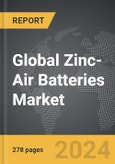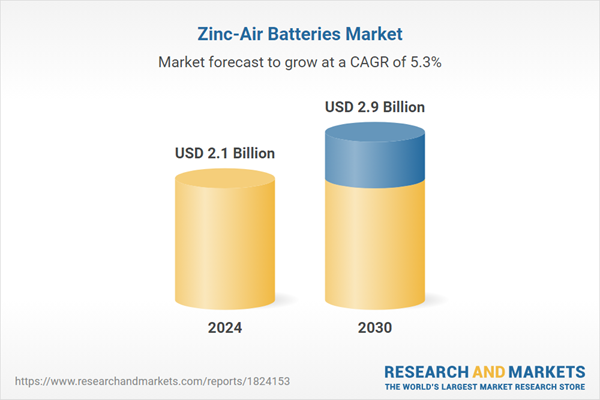Zinc-Air Batteries - Key Trends and Drivers
Zinc-air batteries represent a cutting-edge energy storage technology that has captured significant attention due to their high energy density, environmental sustainability, and cost-effectiveness. These batteries differ from traditional models by using zinc and oxygen from the air as their primary components, which makes them safer and less harmful to the environment. Zinc-air batteries operate through a chemical reaction where zinc is oxidized by oxygen from the atmosphere to produce electricity. This design leads to several notable advantages, including a theoretical energy density that surpasses that of lithium-ion batteries, making zinc-air batteries ideal for applications requiring long-duration power. Additionally, the absence of flammable components reduces fire risks, enhancing their safety for use in consumer electronics and large-scale energy storage systems alike. Furthermore, zinc is abundantly available and less expensive compared to the rare metals used in lithium-ion batteries, providing a more sustainable and economically viable solution.Technological advancements have significantly improved the efficiency, lifespan, and overall performance of zinc-air batteries. Key developments include the creation of advanced catalysts that facilitate the oxygen reduction reaction, a crucial process for the battery's operation. This has led to better energy conversion efficiency and increased battery lifespan. Researchers are also experimenting with new electrode materials and designs to enhance the battery’ s rechargeability, addressing one of the primary challenges associated with zinc-air technology. Innovations such as the use of bifunctional catalysts and hybrid materials have shown promise in increasing cycle life and reducing energy losses. Additionally, there has been a concerted effort to miniaturize these batteries and develop flexible designs, enabling their integration into wearable devices and medical implants. These advancements are not only expanding the practical applications of zinc-air batteries but also making them more competitive with established battery technologies like lithium-ion.
The growth in the zinc-air battery market is driven by several factors. Increasing demand for renewable energy storage solutions has propelled interest in zinc-air batteries, as they provide a sustainable and efficient way to store excess energy generated from renewable sources like solar and wind. This is crucial for balancing supply and demand in renewable energy systems. The rising adoption of electric vehicles (EVs) also presents a significant growth opportunity. Zinc-air batteries could potentially offer a safer and more energy-dense alternative to the lithium-ion batteries currently used in EVs, addressing safety concerns and extending driving ranges. Additionally, the consumer electronics market, especially in regions with strict environmental regulations, is seeing a shift towards greener, safer battery options, further boosting demand for zinc-air technology. The relatively low cost of zinc compared to lithium and cobalt makes zinc-air batteries an economically attractive option for large-scale deployment, especially in grid storage and backup power applications. Government policies and incentives aimed at promoting sustainable technologies are also playing a crucial role in supporting the adoption of zinc-air batteries. These policies include subsidies for research and development, tax incentives for green technology deployment, and regulatory frameworks that encourage the use of environmentally friendly energy storage solutions. Overall, the convergence of technological innovation, increasing market demand for sustainable energy storage, and supportive regulatory frameworks is driving the growth of the zinc-air battery market, positioning it as a key player in the future of energy storage.
Report Scope
The report analyzes the Zinc-Air Batteries market, presented in terms of market value. The analysis covers the key segments and geographic regions outlined below.- Segments: Type (Rechargeable, Non-Rechargeable); Application (Small Devices, Remote Signaling & Communications, Safety Lamps, Electric Cars, Other Applications).
- Geographic Regions/Countries: World; United States; Canada; Japan; China; Europe (France; Germany; Italy; United Kingdom; Spain; Russia; and Rest of Europe); Asia-Pacific (Australia; India; South Korea; and Rest of Asia-Pacific); Latin America (Argentina; Brazil; Mexico; and Rest of Latin America); Middle East (Iran; Israel; Saudi Arabia; United Arab Emirates; and Rest of Middle East); and Africa.
Key Insights:
- Market Growth: Understand the significant growth trajectory of the Rechargeable Batteries segment, which is expected to reach US$2.1 Billion by 2030 with a CAGR of a 6%. The Non-Rechargeable Batteries segment is also set to grow at 3.6% CAGR over the analysis period.
- Regional Analysis: Gain insights into the U.S. market, valued at $564.3 Million in 2024, and China, forecasted to grow at an impressive 8.9% CAGR to reach $642.5 Million by 2030. Discover growth trends in other key regions, including Japan, Canada, Germany, and the Asia-Pacific.
Why You Should Buy This Report:
- Detailed Market Analysis: Access a thorough analysis of the Global Zinc-Air Batteries Market, covering all major geographic regions and market segments.
- Competitive Insights: Get an overview of the competitive landscape, including the market presence of major players across different geographies.
- Future Trends and Drivers: Understand the key trends and drivers shaping the future of the Global Zinc-Air Batteries Market.
- Actionable Insights: Benefit from actionable insights that can help you identify new revenue opportunities and make strategic business decisions.
Key Questions Answered:
- How is the Global Zinc-Air Batteries Market expected to evolve by 2030?
- What are the main drivers and restraints affecting the market?
- Which market segments will grow the most over the forecast period?
- How will market shares for different regions and segments change by 2030?
- Who are the leading players in the market, and what are their prospects?
Report Features:
- Comprehensive Market Data: Independent analysis of annual sales and market forecasts in US$ Million from 2024 to 2030.
- In-Depth Regional Analysis: Detailed insights into key markets, including the U.S., China, Japan, Canada, Europe, Asia-Pacific, Latin America, Middle East, and Africa.
- Company Profiles: Coverage of players such as Anritsu Corporation, B&K Precision Corporation, Boonton Electronics, Cobham PLC, Fluke South East Asia Pte Ltd. and more.
- Complimentary Updates: Receive free report updates for one year to keep you informed of the latest market developments.
Some of the 32 companies featured in this Zinc-Air Batteries market report include:
- Berkshire Hathaway
- Duracell, Inc.
- Energizer Holdings, Inc.
- GP Batteries International Ltd.
- Panasonic Energy Europe NV
- Renata SA
- Sony Electronics, Inc.
- Spectrum Brands, Inc.
- VARTA Microbattery GmbH
This edition integrates the latest global trade and economic shifts into comprehensive market analysis. Key updates include:
- Tariff and Trade Impact: Insights into global tariff negotiations across 180+ countries, with analysis of supply chain turbulence, sourcing disruptions, and geographic realignment. Special focus on 2025 as a pivotal year for trade tensions, including updated perspectives on the Trump-era tariffs.
- Adjusted Forecasts and Analytics: Revised global and regional market forecasts through 2030, incorporating tariff effects, economic uncertainty, and structural changes in globalization. Includes historical analysis from 2015 to 2023.
- Strategic Market Dynamics: Evaluation of revised market prospects, regional outlooks, and key economic indicators such as population and urbanization trends.
- Innovation & Technology Trends: Latest developments in product and process innovation, emerging technologies, and key industry drivers shaping the competitive landscape.
- Competitive Intelligence: Updated global market share estimates for 2025, competitive positioning of major players (Strong/Active/Niche/Trivial), and refined focus on leading global brands and core players.
- Expert Insight & Commentary: Strategic analysis from economists, trade experts, and domain specialists to contextualize market shifts and identify emerging opportunities.
Table of Contents
Companies Mentioned (Partial List)
A selection of companies mentioned in this report includes, but is not limited to:
- Berkshire Hathaway
- Duracell, Inc.
- Energizer Holdings, Inc.
- GP Batteries International Ltd.
- Panasonic Energy Europe NV
- Renata SA
- Sony Electronics, Inc.
- Spectrum Brands, Inc.
- VARTA Microbattery GmbH
Table Information
| Report Attribute | Details |
|---|---|
| No. of Pages | 278 |
| Published | December 2025 |
| Forecast Period | 2024 - 2030 |
| Estimated Market Value ( USD | $ 2.1 Billion |
| Forecasted Market Value ( USD | $ 2.9 Billion |
| Compound Annual Growth Rate | 5.3% |
| Regions Covered | Global |









